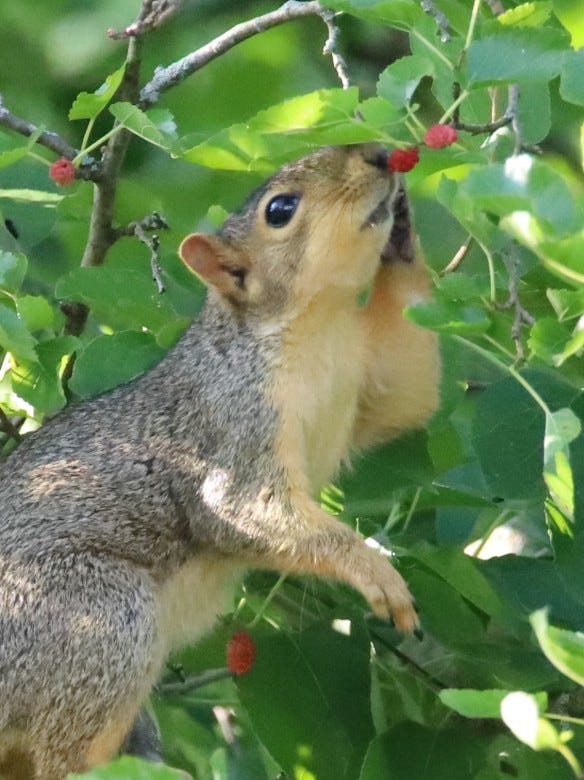Lots to Mull Over & Mulberry Season
For many years, my only knowledge of mulberries was the nursery rhyme about children dancing around a mulberry bush. The mulberry was kind of a mythical fruit for me, something that existed only in fairy tales, not in the real world. It was not until I was in my late 30s that I encountered an actual mulberry tree loaded with ripe fruit. One taste of those divine berries, I realized what a delicious treat I’d been missing out on. These days I’m like a kid in a candy store when I come across a mulberry tree laden with fruit ready to pick. Who wouldn’t just stand and eat and fill their bellies with nature’s candy?
Mulberries are also one of Mother Nature’s best health foods. A cup of the berries contains only 60 calories, yet is rich in antioxidants, fiber, vitamins A, B and K, potassium, riboflavin, iron, magnesium and potassium. The bark, berries, and leaves of the various mulberry varieties have been used for centuries in various ways. The black mulberry berries are laxative, tonic for the blood, and anti-inflammatory. The leaves are antibacterial and are great during a respiratory imbalance as they can induce sweating and end a fever, while also encouraging the expulsion of congestion in the lungs. The stems are anti-rheumatic and pain relieving. Furthermore, the root bark has been used to relieve coughing or to support healthy blood pressure.
Meanwhile, the berries have a 10 percent sugar content. They can be used to make a variety of dishes such as jams and jellies, and an excellent wine. That is, if your wildlife neighbors are willing to share some berries with you.
In fact, some fruit and berry growers will plant mulberries next to their orchards as decoy trees. They know that birds and other wildlife will often leave their crops alone to dine on ripe mulberries. More than 60 species of birds eat mulberries. This long list includes quail, wild turkeys, indigo buntings, tanagers, catbirds, mockingbirds, brown thrashers, bluebirds and great crested flycatchers, to name but a few. As many as 20 different species of birds have been seen dining in a single mulberry tree. Deer and raccoons, even opossums and chipmunks also partake of the sugary berries. Mulberries are so important to squirrels that the planting of mulberries is often recommended to landowners who want to manage their forests for bushytails.
If you are going to plant a mulberry tree, I would recommend that you plant a native red mulberry. Its fruiting season is much longer than that of the white mulberry. In addition, many folks prefer the taste of red mulberries.
To get your mulberry fixe, consider making a field trip to Habitera Farms, the largest mulberry farm in the United States. Located in Northern California, they offer pesticide-free Himalayan Mulberries.
Food For Thought
Words, songs, inspiration and lessons I saved, read, wrote down, and savored this month.
READ - In The Darkness is Heavy. And So Is The Light, Ẹniafe Isis offers a word on the collective grief we are experiencing these days.
READ - The Super Luxe History of Pineapples—And Why They Used to Cost $8000
READ - Turn Your Garden Into an ‘Ark of Taste’ for Nearly Lost Plants
LISTEN - 13 edible SoCal wildflowers and what you need to know about them
Words, Lessons & Inspiration



Opportunities
HISTORY
Mulberry plant history goes back a long way. Most of the ancient civilizations of the world cultivated mulberry trees for their delicious berries. They also used the tall trees with spreading canopies for shade trees. Once it was determined that the huge green mulberry leaves could be fed to livestock, the uses for mulberry trees expanded. The leaves of the white mulberry also proved to be excellent food for silkworms in the silk trade. It was the Romans that brought mulberry trees to Britain when they invaded. They used the trees for medicinal purposes, using mulberry leaves to treat diseases of the mouth, trachea and lungs.
By the 17th century, people were also using the roots of mulberry trees to get rid of tapeworms. It was only after that - during Tudor times - that they became prized in Europe for their succulent berries. It is said that Henry VIII had a mulberry tree planted in his Chelsea estate. Later, King James I decided that Britain should compete with France in silk making. He brought in ten thousand mulberry trees to provide food for the silkworms, planting some in a large mulberry garden near Buckingham Palace. The silkworm project failed because the King bought black mulberry trees instead off the white ones that silkworms like. And the mulberry fever spread to the new world as well.
COOK
PRESERVE
STORE
Store mulberries in the fridge for up to two days – place them on a plate lined with paper towel and cover with plastic wrap. Only wash them when you’re ready to eat.













